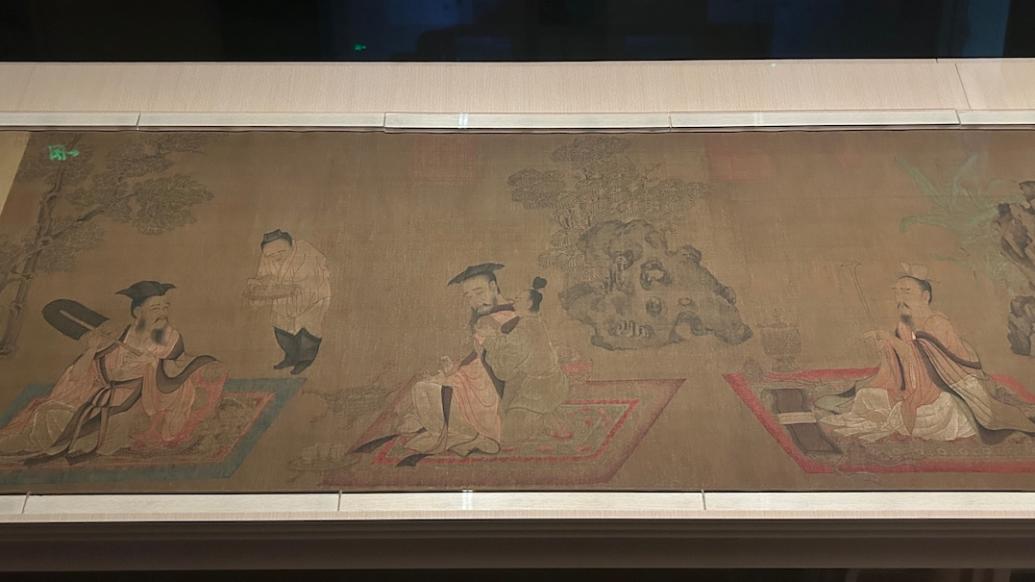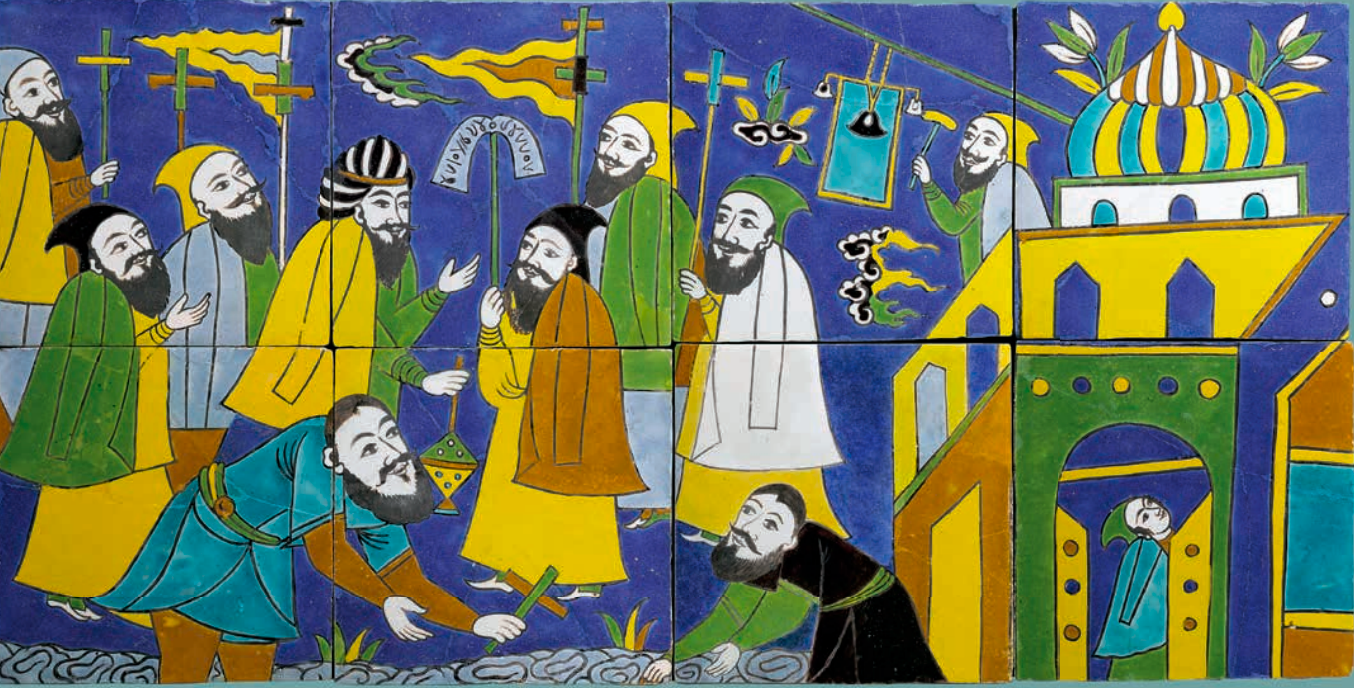

The galleries of Chinese paintings and calligraphy at the Shanghai Museum are among the few permanent exhibitions of ancient Chinese painting and calligraphy history available both domestically and internationally. With the construction and gradual opening of the eastern wing of the Shanghai Museum, the newly upgraded and creatively redesigned art gallery is expected to open to the public in November 2024. Today, The Paper Arts visited the painting gallery in the East Wing for an exclusive preview.
Similar to the gallery of calligraphy, the newly upgraded painting gallery has seen a comprehensive enhancement in terms of content, functionality, and space. In the first round of exhibits, the museum features several "treasures" that have been kept in the vault, headlined by Sun Wei's Tang Dynasty work "High Leisure," along with notable pieces such as Xu Xi's "Snowy Bamboo," Dong Yuan's "Summer Mountain," an anonymous work from the Southern Song Dynasty "Welcoming the Virtuous Emperor," Zhao Ji's "Willow and Wild Goose," and Qian Xuan's "Floating Jade Mountain Residing." Additionally, the initial exhibits showcase representative works from three of the "Four Masters of the Yuan" — Wang Meng's "Qing Bian Retreat," Ni Zan's "Six Gentlemen," and Wu Zhen's "Fisherman," with a fresh combination of works from the "Four Masters of the Ming" displayed, including Wen Zhengming's representative work "True Appreciation Studio" and Tang Yin's first-class work "Companions in Spring Mountains." The newly upgraded painting gallery has also separated the previously combined Ming and Qing sections, adding a modern painting section to enhance the overall historical narrative.

Exhibition scene
The "Painting Gallery" in the East Wing of the museum connects with the "Calligraphy Gallery," featuring the "Eight Landscapes of Calligraphy and Painting" at various points around the exhibition hall—Liufa Pavilion, Shuangqing Bridge, and Yuke Dao. The focal point is the painting gallery's meticulously crafted "Liufa Pavilion," with its off-white exterior, reflective glass from all sides, and digitally rotating screens, creating a dazzlingly radiant "illusion" for visitors. This space serves as both a decorative piece and a wall screen, allowing for a moment of contemplation before officially viewing the exhibition. The "Liufa Pavilion" is inspired by the "Six Laws" from the Southern Dynasties scholar Xie He's "Records on Ancient Painting," which represent the aesthetic principles for evaluating painting throughout Chinese history. However, what is presented here deviates from the traditional form of Chinese pavilions, resembling a contemporary interpretation of a classic concept.

The "Liufa Pavilion," one of the "Eight Landscapes of Calligraphy and Painting"

"Yuke Dao," another of the "Eight Landscapes of Calligraphy and Painting"
At the end of the painting gallery, "Yuke Dao" serves a similar purpose. Located at the intersection of the calligraphy gallery, the Shanghai painting gallery, and the special gallery, the green-glazed giant bamboo is interspersed among pebbles and blue bricks, casting a flicker of shadows with the gentle sound of birds chirping in the background, creating an aura of nature. "Yuke" derives from the name of Wen Tong, the founder of the "Huizhou Bamboo School." The form of the giant bamboo is inspired by the bamboo in Xu Xi's "Snowy Bamboo," with the dancing shadows cast on the ground reflecting the bamboo from the Song Dynasty attributed to Wen Tong's "Ink Bamboo."
National treasure-level relics making their debut
“For this inaugural exhibition in the painting gallery, we are unveiling national treasures that have been 'stored away' for a long time,” said Ling Lizhong, Director of the Calligraphy and Painting Department at the Shanghai Museum. The exhibition in the painting gallery features more than 100 displayed paintings, including some works that are making their debut, while others haven't been seen for a long time.

Exhibition scene - Sun Wei's "High Leisure"
Among the treasures revealed by the museum, many have previously made headlines in the list of exhibits for the "National Treasure Exhibition of Jin, Tang, Song, and Yuan Dynasties," like the calligraphy of Wang Xizhi’s "Shangyu Scroll" and Wang Xianzhi’s "Duck Head Pill Scroll." This time in the painting gallery, notable works include Sun Wei's "High Leisure" from the Tang Dynasty, Xu Xi's "Snowy Bamboo," Dong Yuan's "Summer Mountain," and Zhao Ji's "Willow and Wild Goose."
“Looking back at the Tang and Song sections from here feels like stepping into the national treasure exhibition of Jin, Tang, Song, and Yuan from 2002,” Ling remarked, noting the addition of a significant exhibit — the Southern Song anonymous piece "Welcoming the Virtuous Emperor," which has not been displayed for over 60 years. It is also a representative piece from art history that once graced the cover of art publication in the 1980s.
Xu Xi's "Snowy Bamboo" employs ink wash techniques to depict a structure of dead wood, bamboo, and stones, using white space to indicate accumulating snow. Although there are differing academic views about this painting, its technique aligns with the historical methods attributed to Xu Xi, making it one of the earliest works representing his style.

Xu Xi's "Snowy Bamboo"
During the Five Dynasties and Ten Kingdoms period, bird and flower painting saw the emergence of two major stylistic schools, represented by Huang Quan and Xu Xi, showcasing different tastes of "wealthy elegance" and "wild aloofness." "The 'Snowy Bamboo' is highly expressive, pioneering a new path for later ink painting, carrying significant historical importance." An interesting detail about this painting is a bamboo stalk set between rocks in the center, inscribed in seal script: "This bamboo is worth a hundred taels of gold," believed to be inscribed by Xu Xuan during the Five Dynasties, which is also among the reasons earlier scholars dated this piece to the "Five Dynasties."

Exhibition scene - Southern Song, Anonymous, "Welcoming the Virtuous Emperor" (Detail)
The central section of "Welcoming the Virtuous Emperor" measures nearly two meters high and one meter wide, making it a "giant" among Southern Song hanging scrolls. According to Ling Lizhong, differing interpretations have emerged over time regarding its depicted content. The widely accepted view posits that it portrays the story of Li Heng, the Tang Suzong, welcoming the retired Emperor Li Longji back from Shu after the An Lushan Rebellion. Surrounded by a crowd, both emperors appear under their respective canopies; the figure dressed in purple is Tang Suzong while the one in yellow is Tang Xuanzong. "When he left, he was an emperor; when he returned, he was a retired emperor, and he was greeted by his son, Tang Suzong," Ling explains, noting that neither of the "leading gentlemen" are in the center stage. Above the figure in red robes is a yellow canopy, while the figure in yellow is covered by a red canopy. "The artist excellently balanced colors to address this situation, portraying everyone as 'leading gentlemen.'" The crowd depicted largely consists of elderly men and children, and the accompanying officials lack a sense of solemnity. The intricate arrangement of characters, diverse appearances, and subtle expressions bring life to a historical moment.

Exhibition scene - Southern Song, Anonymous, "Welcoming the Virtuous Emperor" (Partial)
The two paintings, Xu Xi's "Snowy Bamboo" and the Southern Song's "Welcoming the Virtuous Emperor," are both hanging scrolls. As scrolls are not suitable for long-term exhibition, these works are only making short appearances during the opening of the new gallery.
The exhibited "High Leisure" by Sun Wei is a significant representative of figure painting in the Tang Dynasty, recognized as a textbook-level work. Research indicates that this painting is a remnant of the "Seven Sages of the Bamboo Grove," depicting the figures Shan Tao, Wang Rong, Liu Ling, and Ruan Ji. The painting bears an inscription from Song Huizong that reads "Sun Wei's High Leisure."

Exhibition scene - Sun Wei's "High Leisure"
“This piece embodies typical meticulous coloring. Sun Wei’s expressive linework is superb, offering different textures for clothing, skin, and props through distinct strokes. The colors of the blankets and garments remain exceedingly vibrant to this day.”

Exhibition scene - Sun Wei's "High Leisure" (Detail)

Exhibition scene - Tang Dynasty, Sun Wei's "High Leisure" (Detail)
Although this is a figure painting, the background also includes mountains, rocks, bamboo, and banana plants. This painting holds additional


